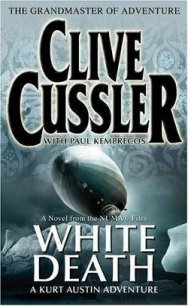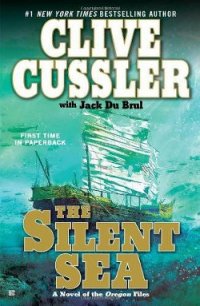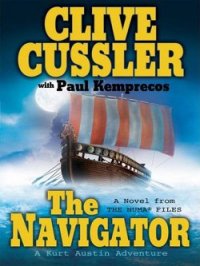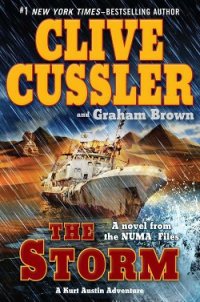Lost City - Cussler Clive (читать онлайн полную книгу .txt) 📗
"The cameras will be rolling every minute and we may pick up something when we look at the pictures," Gamay said. "I'll send photos back as soon as we have something."
After Gamay hung up, she relayed Osborne's words to Paul. It was time to go. A crowd of people gathered on the fantail to watch. One of them was a trim man with salt-and-pepper hair who came over and wished them well. Charlie Beck was the leader of a team that had been training the ship's crew in security procedures.
"You've got a lot of guts going down in that thing," he said. "The SEAL delivery vehicles always made me claustrophobic."
"It will be a little tight," Gamay said, "but it's only for a few hours."
When it wasn't diving, the submersible was housed on the aft deck in a special building known as the Alvin hangar. Now the hangar doors opened and the Alvin emerged, moving toward the stern on a set of rails, finally coming to a halt under the A-frame. The Trouts and the pilot climbed a set of stairs and walked across a narrow bridge to the sub's red-painted top, or "sail," as it was called. They took their shoes off and squeezed through the twenty-inch hatch.
Two escort divers climbed onto the submersible and attached a winch line from the A-frame. While this was happening, a small inflatable boat was launched over the side. Controlled by an engineer on the "Dog House," a small room atop the hangar, the A-frame winched the eighteen-ton vehicle off the deck and lowered it into the ocean with the escort divers still hanging on. The divers removed the lines securing the tool basket at the bow end of the submersible, made one last check and said their good-byes down the hatch, then they swam to the inflatable to be taken back to the ship.
They took their seats in the submersible's tight cabin, a titanium pressure sphere eighty-two inches in diameter. Practically every inch
of the sphere's interior was covered with panels that contained switches for power activation, ballast control, monitors for oxygen and carbon dioxide, and other instruments. The pilot sat on a low raised stool where she could control the vehicle with the joystick in front of her.
The Trouts squeezed into the tight space on either side of the pilot, sitting on cushions that provided a modicum of comfort. Despite the tight quarters, Trout was excited. Only his New England reserve kept him from shouting with joy. For a deep-ocean geologist, the cramped quarters of the Alvin were better than a deluxe stateroom on the QE2.
Since its construction for the U.S. Navy in 1964, the Alvin's exploits had made it the world's most famous submersible. The stubby twenty-five-foot-long little vehicle with the singing chipmunk's name could dive as deep as fourteen thousand feet. The vehicle had made international headlines after it found a lost hydrogen bomb off the coast of Spain. On another expedition, it transported the first visitors to the grave of the Titanic.
Seats on the Alvin were difficult to come by. Trout considered himself extremely lucky. If not for the urgent nature of the expedition, he might have waited years to go on a dive, even with his impressive NUMA credentials and inside connections.
The pilot was a young marine biologist from South Carolina whose name was Sandy Jackson. With her calm, cool demeanor and laconic drawl, Sandy seemed like a younger version of the legendary aviatrix Jacqueline Cochran. She was a slim woman in her thirties, and under her jeans and wool sweater was the wiry physique of a marathon runner. Hair the hue of raw carrots was tucked under the tan Alvin baseball cap, which she wore with its navy blue visor backward.
While Gamay had settled for a functional one-piece jumpsuit, Trout saw no reason to change his sartorial habits for a deep-sea dive.
He was impeccably dressed, as usual. His stone washed jeans were tailored, his button-down shirt came from Brooks Brothers and he wore one of the large colorful bow ties that he collected. This one had a seahorse pattern. His bomber jacket was made of the finest Italian leather. Even his silk long underwear was custom-made. His light brown hair was carefully parted down the middle and swept back at the temples, making him look like a character from an F. Scott Fitzgerald novel.
"This is an easy trip," Sandy said as the tanks filled with water and the submersible began its twenty-five-hundred-foot dive. "Alvin dives around a hundred feet a minute, which means we'll be on the bottom in less than a half hour. If we were diving to the fifteen-thousand-foot max, we'd drop for an hour and a half. We usually play classical music on the way down and soft rock on the ascent," Sandy said, "but it's up to you."
"Mozart would set the proper mood," Gamay said.
A moment later, the cabin was filled with the lilting strains of a piano concerto.
"We're about midway," Sandy said after fifteen minutes.
Trout greeted the announcement with a broad grin. "Can't wait to see this underwater metropolis."
While the Alvin sank into the depths, the Atlantis moved in a slow circle above the dive area and the support crew gathered with the chief scientist in the top lab, between the bridge and the chart room, where the dive is monitored.
Sandy reported their progress with the acoustic telephone, acknowledged the garbled reply, then turned to the Trouts.
The submarine continued its descent.
"What do you folks know about the Lost City?" she said.
"From what I've read, it was found by accident in the year 2000. The discovery apparently came as quite a surprise," Gamay said.
Sandy nodded. "Surprise doesn't begin to describe our reaction.
Shell-shocked would be a more accurate term. We were towing the Argo II behind the ship looking for volcanic activity on the mid-ocean ridge. Around midnight, the second shift leader saw what looked like frozen white Christmas trees on the video monitor screens and realized we'd hit hydrothermal vents. We didn't see tube worms or clams like those found at other ocean vent areas. Word spread like wildfire. Before long, everyone on the ship was trying to squeeze into the control van. By then, we were starting to see the towers."
"I heard one scientist say that if the Lost City were on land, it would be a national park," Trout said.
"It wasn't just what we found but where we found them. Most of the vents that have previously been discovered, like the 'black smokers' for instance, were near mid-oceanic ridges formed by tectonic plates. The Lost City is nine miles from the nearest volcanic center. We sent the Alvin down the next day."
"I understand some columns are nearly twenty stories high," Trout said.
Sandy switched on the outside floodlights and glanced through her view port. "See for yourself."
Paul and Gamay peered through the circular windows. They had seen the still photos and videos of the Lost City, but nothing could have prepared them for the primordial scene that unfolded before them. Paul's large hazel eyes blinked in excitement as the vehicle glided over a fantastic forest of lofty columns. Gamay, who was equally enthralled, said the columns reminded her of the "snow ghosts" that form atop mountains where supercooled fog forms tufts of rime on the tree branches.
The carbonate and mica pillars ranged in color from stark white to beige. Gamay knew from her research that the lighter-colored columns were active while the darker ones were extinct. The towers soared to multiple, feathery spires at their summits. Delicate white flanges jutted out from the sides the way mushrooms grow on old
tree trunks. New crystals were continuously forming, giving the edges the appearance of Spanish lace.




